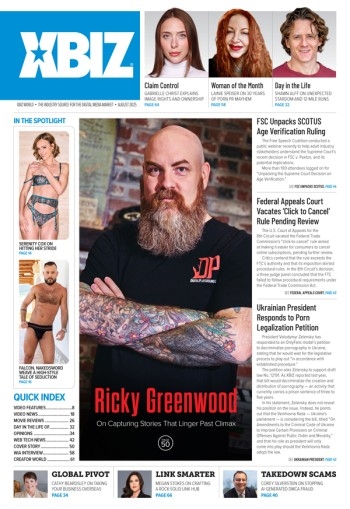Recent research has highlighted the presence in a wide variety of adult toys of possibly harmful chemicals, especially phthalates, a category of colorless, oil-like chemicals that are used to make plastics more pliable. The supposed danger has garnered headlines and raised the ire of some politicians. Meanwhile, others contend the risks are overstated.
Phthalates were pushed into the spotlight in June, when the San Francisco Board of Supervisors passed legislation banning them from children's toys, as well as items like baby bottles and pacifiers, made or sold in the city. The chemical has been linked to problems including birth defects, early puberty, reduced testosterone and asthma.
Even plastic items as durable as blood bags, the plastic pouches used in blood donation and transfusion, have been known to leach phthalates into the blood stored in them. Phthalates in vinyl products for small children have been banned in the European Union since 1999.
While the San Francisco ban, which takes effect Dec. 1, is unlikely to send health inspectors into adult retail stores, it caught the attention of individuals who make, sell and use adult sex toys. Violet Blue, who posts a blog on the website Tiny Nibbles: Open Source Sex, said sex toys "likely provide a very effective means to get these harmful chemicals into the body: by rubbing them in a high-temperature orifice."
Jelly vs. Silicone
Phthalates are the softening agents in sex toys known as "jellies," which make up the bulk of the adult toy market and are used in "realistic" sex toy materials such as Softskin, Cyberskin and Futurotic. Jelly rubber toys are colorful, shiny and visually appealing, though they generally have a chemical odor and can exude enough of the oily chemicals to stain fabric or wood. "It's the ultimate 'mystery material,' mass-produced in mostly Chinese chemical factories with so many mixtures and versions of the material it's difficult to pin down a set of manufacturer's ingredients," Blue says.
The chemicals in jelly toys usually don't cause physical reactions, but they make the toys' surfaces porous, which makes them fertile environments for bacteria and other microbes. Manufacturers and distributors get around liability problems and government regulation by labeling the toys as "novelties," gag gifts not intended for actual use. That isn't the way of the world, though, and non-discriminating buyers often find themselves with sex aids that are inexpensive but over time become chemically unstable and riddled with bacteria.
Silicone, on the other hand, is nonporous, easy to clean and even sterilize, and longer-lasting than jelly rubber. It's free of seams and snags, warms quickly to body temperature and stays warm. Because it doesn't contain latex, people with sensitivities to latex can use silicone products without fear.
"When we started, silicone was not mainstream," said Metis Black, president of Tantus, a San Diego-based adult toy manufacturer. Nine years ago, Black says, her toys sold mostly to the lesbian niche market.
In time, however, Black "decided we were going to be an education-based manufacturer," a role she bolsters with seminars at trade shows.
Although toy-maker Tony Levine's lines are vinyl instead of silicone, he said he also committed to putting out nontoxic product when he started Big Teaze Toys five years ago. Rigorous testing ensures that items such as the I Rub My Duckie vibrator are free of phthalates, lead, cadmium and latex.
"It's been a good-selling point for us, especially in Europe, where people are a lot more sensitive" to environmental issues, Levine said.
Smitten Kitten
The Smitten Kitten, founded three years ago in Minneapolis, had been open only a few days when its staff discovered the less-attractive aspects of jelly-latex products. "We got a shipment in August 2003, and the boxes were wet, as if oil had been spilled on them," store owner Jennifer Pritchett told XBIZ, adding that the cartons were emitting noxious fumes. "The items were jellies, and the phthalates had leaked."
That's when the store staff did some research and found out about the chemicals jellies can leak and give off gas. "We notified our customers and credited the price [of] silicone toys" if the customer wanted to exchange, Pritchett said. "We felt an ethical obligation, once we knew, to tell our customers and rectify the situation."
Today, Pritchett said, her store stays away completely from jellies and "mystery rubber." The Smitten Kitten also is setting up a website, BadVibes.org, to educate consumers about noxious chemicals contained in sex toys.
Makers of plastic products and some scientists argue that the risk of dangerous exposure to phthalates from skin contact with toys and even chewing on them is small to none. Rebecca Goldin, a George Mason University researcher who analyzes statistics behind headlines, wrote recently that, based on studies with rats, no one really knows what constitutes an unhealthy dose of phthalates for humans. She also said that because our main source of phthalates is food (especially seafood), controlling phthalates in plastics and other nonfood items would have almost no effect on exposure.
But Pritchett doesn't see even a small risk as tenable. "To me, the burden of proof is on the manufacturer: Prove to me they're safe," she said. From what she's seen, she added, "there's no way I would expose my employees and customers."
Miko Exoticwear in Providence, R.I., stocks two jelly-latex toys, but only two, and store manager Rhiannon Kopynec told XBIZ that selling them "opens a conversation about the material."
Miko staffers make sure to tell customers who buy jellies how to use and clean the items and not to use them indefinitely. "We send them home with information and condoms," Kopynec said.
Silicone toys and sex toys made of even less-porous materials such as glass and metal are more expensive than jellies, but the price difference — perhaps $10-$15 for comparable items made of jelly rubber and of silicone — isn't enormous, and the toys don't have to be replaced as often.
Besides, what a retailer might gain in selling a cheap toy he might lose in other ways. "If you're selling a lesser toy and she gets a rash, she's going to take a week to heal," Black said. "That's a week's worth of no porn, no lingerie, no lubes. Silicone makes repeat customers."
As women continue to take control of their erotic lives and make consumer decisions for the bedroom, sex toys free of "mystery rubber" and off-putting chemicals are likely to become increasingly popular. Describing what she saw as a man's approach to adult toy purchase, Black said, "If he took it back to his hotel room and used it a few times, it was a good buy. Women are different."
Calling women "the more critical shoppers," Levine concurred. "Once women start to make demands as they have with other products, this industry will continue to change too."








